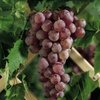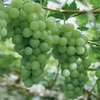 |
PLANT TYPE: Perennial SCIENTIFIC NAME: Vitis ZONE / HARDINESS: Hardy to zone 3 to 5. Check each individual variety MATURE PLANT SIZE: Vine; determined by trellis/support structure and pruning LIGHT: Full Sun to partial shade SOIL TYPE: Rich moist well-drained moderately fertile loam pH RANGE: 6.0 to 7.0 |
OVERVIEW:
Grapes are the most widely grown fruit in the world and unlike most fruit crops, many grapes are native to North America. The wild grapes found by early settlers were quickly rejected because they were high in acid, low in sugar and uniquely flavored.
Grapes differ greatly in their tolerance to disease and insect pests and to cold winter temperatures. With proper care, grapevines can be grown in most locations in New York, although getting fruit on those vines is often challenging.
SITE SELECTION:
Site Selection for Grapes: Choosing the right spot for any long-lived perennial plant is important. More so with grapes as the right site will help reduce disease problems and ensure fruit for many years to come. The 4 factors to consider are:
PLANTING / SOWING:
Planting Grapes: Space grapes 8 feet apart in rows 10-12 feet apart. The soil should be lightly packed around the plant and well watered until the grape begins to grow. They can be fertilized 3-4 weeks after they are planted out with a balanced fertilizer.
SOIL PREPERATION:
Soil Preparation: Since this will be the permannt home for the grape it is important to properly prepare the soil before planting. Grapes like a morderately acid soil (pH 5.5-6.0), so liming is not generally required, unless your soil is very acidic. Grapes are not heavy feeders, but working some compost into the soil should help them get a good start.
1. Soil Drainage. Grapes do not like wet feet, so avoid sites where the soil is heavy or water sits for any amount of time.
2. Air Movement. Good air circulation will reduce disease problems.
3. Frost pockets. Avoid frost pockets, plant grapes in an area where they will not be exposed to late spring frosts or early fall ones.
4. Sun Exposure. Grapes should be planted in a location that receives full sun.
PRUNING:
Since grapes can be very prolific and only bear fruit on 1 year old wood, they need to be pruned and trained to bear an abundant harvest. The following process describes a common pruning method called the 4 arm Kniffen system, but the principles can be applied to any form. This system involves using two strands of galvanized steel wires at 3 feet high and 6 feet high, spaced 3 feet apart on posts 16 feet apart. Grapes should be pruned in late winter, early spring before the buds have begun to grow.
Year 1: In the first year of growth the grapes should be tied up to a stake and only the strongest 2 shoots alllowed to grow.
Year 2: Select the stronger of the two canes to be the main trunk of your grape. If the cane has only reached the first wire then restrict it to two shoots. If it has reached the top wire, once the shoots begin to grow remove all but the strongest 4 or 5 at each wire, these will be the arms of your grape vine.
Year 3: At each wire selct the strongest cane going in each direction and prune to 3-4 buds in each cane. These will provide the fruiting wood for next year.
Year 4 and beyond: Finally the first fruiting year has arrived. Select the stronger cane at each wire and prune to 6-10 buds each. This cane will bear the grapes. Also leave one shoot in each direction pruned to 2-3 buds. This will supply next years fruiting canes and is called a spur. The fruit should be harvested in the fall. The colour will change before the grapes are ripe, so a taste test is the best way to know when they are ready. In future years prune back the previous years wood and select a new fruiting branch and spur.
HARVESTING:
The sure sign of ripeness is the grape sweetness, and, of course, the most reliable method for homeowners to test this is to taste them! Unlike some other fruits, once the grapes are cut from the vine, they will not ripen any further. So, be sure the grapes are ready before you harvest.
Once you decide to harvest, grapes can be stored up to eight weeks, depending on the cultivar and storage conditions. Ideally, grapes should be stored at 32F with 85 percent relative humidity. If you have an abundance of grapes, there are some good alternatives to eating them fresh.
USAGE:
Grapes are excellent for making jellies, jams, juice and wine.
Need more information, visit this page:
Oregon State University Extension Service
| POPULAR GRAPE VARIETIES |

Valiant GrapesHardy to Zone 3 |

Agawam GrapesHardy to Zone 5 |

Kay Gray GrapesHardy to Zone 3 |